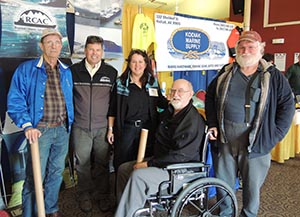By Lisa Matlock
Outreach Coordinator

Over the past two months, Executive Director Mark Swanson and I have been traveling as part of the council’s community outreach program to a good number of our downstream communities. The term “downstream” was coined after the Exxon Valdez oil spill, when oil spread across more than a thousand miles of coastline in southcentral Alaska, including the southern Kenai Peninsula and Kodiak Island. Because of this, when industry works on contingency planning for safe oil transportation through Prince William Sound, the council regularly speaks up for downstream communities and resources that could be affected by an accident. So it is important for us to visit these communities to hear from these citizens about how our mission connects to their priorities and community needs.
Visiting Kachemak Bay
In March, we presented a scientific poster at the Kachemak Bay Science Conference about recent chemical dispersants research sponsored by the council. Every two years, at this conference, scientists with ties to the communities of Homer, Seldovia, Port Graham, and Nanwalek get together to share information about their research. Presentations, field trips, workshops, and poster sessions help community members better understand the health of their marine backyard and learn about all kinds of research projects happening there.
Kachemak Bay communities showed great interest in what the council has learned about chemical dispersants through our 25 years of research and how communities can weigh in on changes to policy about dispersants and their use in Alaska. As a recent example, the Environmental Protection Agency accepted public comments about a section of the National Oil and Hazardous Substances Pollution Contingency Plan that regulates which chemical dispersants can be used and how they are used. The scientific poster the council presented at the conference continues to be available through a Homer-based board member for continued outreach in that area.
Visiting Kodiak Island
In recent weeks, the council exhibited our information booth at Kodiak ComFish, an exposition focused primarily on commercial fishing and related subjects in the largest town on Kodiak Island. We met with people from throughout the community to talk about the council and spill response preparedness activities we monitor, such as the Alyeska’s fishing vessel oil spill response program. Through this program, Alyeska pays fishing vessel crews to learn to help clean up oil spills and to be ready to respond quickly if there is a spill. This program helps satisfy Alyeska’s commitment to the residents of Alaska to be ready for an oil spill. The final spring classroom and on-water training days for Kodiak fishing vessels overlapped with the week of ComFish so we were busy answering questions about the program.
After ComFish, we joined Melissa Berns of the Old Harbor Native Corporation on flights to four remote Kodiak Island communities: Old Harbor, Port Lions, Ouzinkie, and Larsen Bay. The opportunity to meet with village and tribal leaders was both instructive and delightful. People living in these small downstream communities are quite interested in council projects, especially the fishing vessel program, chemical dispersant science and policy, and youth involvement activities. Leaders in these Kodiak Island communities also showed great interest in our Incident Command System for Stakeholders workshops. These workshops can help local residents identify how to get their voices heard during an incident such as an oil spill.
Remote but connected
Sometimes these remote communities can seem very far downstream from the tankers that ply Prince William Sound waters, but the people living in them understand perfectly their connection to the larger Gulf of Alaska ecosystem. It is a reminder of the old adage that when we try to pick out anything by itself, we find it hitched to everything else.